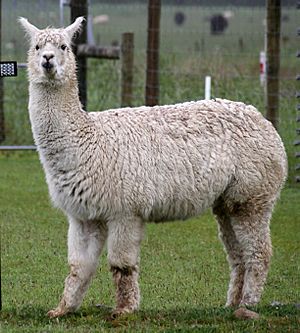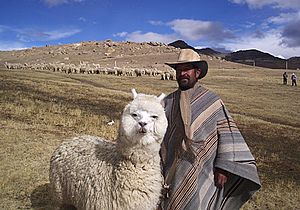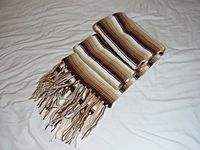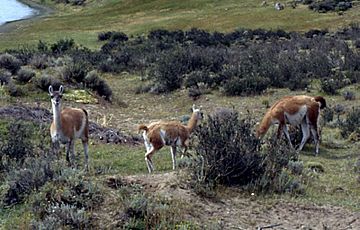Alpaca facts for kids
Quick facts for kids Alpaca |
|
|---|---|
 |
|
| Conservation status | |
| Scientific classification | |
| Genus: |
Lama
|
| Species: |
pacos
|
 |
|
| Alpaca range | |
| Synonyms | |
|
Camelus pacos Linnaeus, 1758 |
|
The alpaca (Lama pacos) is a mammal from South America. It belongs to the camelid family, like camels. Alpacas are often confused with llamas. However, alpacas are usually smaller than llamas. There are two main types, or breeds, of alpaca: the Suri alpaca and the Huacaya alpaca.
Contents
- Where Do Alpacas Come From?
- Meet the Alpaca Breeds
- What Do Alpacas Look Like?
- Where Do Alpacas Live?
- How Do Alpacas Behave?
- How Do Alpacas Communicate?
- How Do Alpacas Reproduce?
- Alpaca Population
- What Do Alpacas Eat?
- How Are Alpacas Used?
- Alpaca Fiber
- Alpacas in Culture
- Fun Facts About Alpacas
- See Also
Where Do Alpacas Come From?
Alpacas were tamed by people thousands of years ago. There are no wild alpacas known today. Their closest wild relative is the vicuña, also from South America. The vicuña is the wild ancestor of the alpaca.
Scientists have found bones of vicuña and guanaco in Peru. These bones are about 12,000 years old. Mummified alpacas and llamas have been found in Peru's Moquegua valley. These mummies are 900 to 1000 years old. The mummies show that both alpaca breeds existed back then.
Meet the Alpaca Breeds
Alpacas come in two main breeds: Suri and Huacaya. These breeds are named for their different types of fiber.

The Huacaya alpaca is the most common type. About 90% of all alpacas are Huacaya. They are believed to have come from Peru after the Spanish arrived. Huacayas have a thick fleece. This warm coat helps them live in the high Andes mountains.
Suri alpacas are less common, making up about 10% of the population. They may have been more common in Peru before the Spanish came. Suris could live in lower areas where a thick coat was not as necessary.
What Do Alpacas Look Like?
An adult alpaca usually stands between 81 and 99 centimeters (32 to 39 inches) tall at the shoulder. They typically weigh between 48 and 90 kilograms (106 to 198 pounds). Male and female alpacas are often similar in weight. Males might weigh around 22.3 kg (49.2 lb). Females might weigh about 21.3 kg (47.0 lb).
Where Do Alpacas Live?
Alpacas live in many parts of South America. They prefer cool, mountainous areas at high altitudes. Herds of alpacas graze on the flat parts of the Andes mountains. You can find them in southern Peru, western Bolivia, Ecuador, and northern Chile. They live at altitudes from 3,500 to 5,000 meters (11,500 to 16,400 feet) above sea level.
Alpacas are easy to care for. They can live in many different environments. In their natural homes, alpacas live near other animals. These include flamingos, condors, spectacled bears, and llamas.
How Do Alpacas Behave?
Alpacas are social animals. They live in family groups, like a herd. A group usually has a leader male, females, and their young. Alpacas warn their herd about danger. They make a loud, high-pitched braying sound. The herd might attack smaller predators. They can kick and even spit at threats. Sometimes, alpacas are used to guard sheep. Their dislike of dog-like animals helps protect the sheep.
Alpacas can be aggressive sometimes. But they are also gentle, smart, and very watchful. Most of the time, alpacas are quiet. Male alpacas can be more active when fighting other alpacas. When they are prey animals, they are careful. They get nervous if someone or another alpaca comes up behind them.
Alpacas have their own "personal space" rules. They create a pecking order, or hierarchy, in their groups. Each alpaca knows which animals are in charge. Young alpacas often follow larger objects. They like to sit near or under them. This is like a baby alpaca staying close to its mother.
How Do Alpacas Communicate?
Alpacas use their bodies to communicate. Spitting is a common way they show dominance. They also spit when they are upset, scared, or annoyed. Another body signal is the "broadside" pose. Their ears are pulled back, and they stand sideways. Male alpacas use this pose to defend their territory.
Male alpacas are usually more aggressive than females. They try to show who is boss in their herd. Sometimes, a strong male will hold down a weaker male's head and neck. This shows his power and dominance.
Alpaca Sounds
Alpacas make many different sounds:
- Humming: Mother alpacas and their babies hum a lot. Alpacas also hum when they are worried. This happens if they are separated from their group. They might hum when they are curious, happy, or careful.
- Snorting: Alpacas snort if another alpaca gets too close to their space.
- Grumbling: Alpacas grumble to warn each other. It sounds like gurgling. This happens if one alpaca invades another's space.
- Clucking: This sound is like a chicken's cluck. Mothers cluck when they are worried about their cria (baby alpaca). Male alpacas cluck to show they are friendly.
- Screaming: Alpaca screams are very loud. They scream if they are handled roughly. They also scream if an enemy attacks them.
- Screeching: This sound is like a bird's cry. It is meant to scare an opponent. Male alpacas often use this sound when fighting for dominance. When a female screeches, it sounds more like a growl. She makes this sound when she is angry.
Why Do Alpacas Spit?
Not all alpacas spit, but they all can. "Spit" is a polite word for it. Sometimes it's just air and saliva. But alpacas often bring up green, grassy stomach contents. They then spit this onto their target. Alpacas mostly spit at other alpacas. But sometimes they will spit at a human.
Spitting can cause "sour mouth." This is when an alpaca's lower lip hangs loose, and its mouth is open.
Alpacas spit for several reasons. A female alpaca spits if she is not interested in a male. This often happens if she thinks she is already pregnant. Both male and female alpacas spit to keep others away from their food. They also spit to protect anything they want. Most alpacas give a warning before spitting. They blow air out and raise their heads. Their ears also look "pinned back."
Signs of stress that can lead to spitting include humming. Other signs are a wrinkle under their eye, drooling, fast breathing, and stomping their feet. When alpacas are interested or alert, they sniff around. They also watch closely or stand still and stare.
Training Alpacas
Alpacas are generally easy to train. They usually respond well to rewards, like food. You can often pet them without them getting upset. Just avoid petting their head or neck. Alpacas are usually easy to herd, even in large groups. When herding, it's best to approach them slowly and quietly. If you don't, it can be dangerous for both the alpacas and the person.
How Do Alpacas Reproduce?
A male alpaca is usually ready to mate between two and three years old. It's best for a young female to wait until she is mature. She should also reach two-thirds of her adult weight before breeding. This age varies, so new breeders often wait until females are 18 months or older.
Alpacas can breed all year. But it is harder to breed them in winter. Most breeding happens in autumn or late spring. A popular way to mate alpacas is "pen mating." This is when a male and female are put together in a pen. Another way is "paddock mating." Here, one male alpaca is put in a large field with several females.
Pregnancy lasts about 11.5 months. Usually, only one baby, called a cria, is born. Twins are very rare, happening about once every 1000 births. Cria usually weigh between 15 and 19 pounds. They can stand 30 to 90 minutes after birth. After giving birth, a female can usually breed again in about two weeks. Cria can be weaned (stop drinking milk) by humans at about six months old. They should weigh around 60 pounds then. But many breeders let the mother decide when to wean her baby.
Alpaca Population
Alpacas are originally from Peru. But they can now be found all over the world in captivity. Peru still has the largest alpaca population. Over half of the world's alpacas live there. The alpaca population dropped a lot after the Spanish invaded the Andes mountains in 1532. About 98% of the animals were killed. The Spanish also brought diseases that were deadly to alpacas.
The European conquest forced alpacas higher into the mountains. They stayed there permanently. Alpacas were almost wiped out. But they were rediscovered in the 1800s by Europeans. People found many uses for them. Alpacas became important during the Industrial Revolution.
What Do Alpacas Eat?
Alpacas chew their food. It mixes with their cud and saliva. Then they swallow it. Alpacas usually eat 1.5% of their body weight each day to grow normally. They mainly need pasture grass, hay, or silage. Some may also need extra energy and protein foods. They will also try to chew on almost anything, like an empty bottle. Most alpaca farmers move their animals to different feeding areas. This lets the grass regrow. It also helps kill parasites before the area is used again. Pasture grass is a great source of protein. When seasons change, the grass's protein level changes. For example, in spring, grass has about 20% protein. In summer, it only has 6%. Alpacas need more energy in winter. This helps them produce body heat and stay warm. They get fiber from hay or long stems. This gives them vitamin E. Green grass has vitamins A and E.
Alpacas can eat natural, unfertilized grass. But farmers can also give them low-protein grass hay. To get selenium and other needed vitamins, domestic alpacas are often fed a daily dose of grain. This gives them extra nutrients not fully found in their main diet. Alpacas in their native grazing areas usually get all the vitamins they need.
How Do Alpacas Digest Food?
Alpacas, like other camelids, have a three-chambered stomach. They also chew their cud. This three-chambered system helps them get the most nutrients from low-quality plants. Alpacas are not true ruminants. Their stomach is different from a cow's stomach.
Alpacas chew their food in a figure-eight motion. They swallow it, and it goes into one of the stomach chambers. The first two chambers (C1 and C2) are where food starts to break down. The alpaca then absorbs more nutrients and water in the first part of the third chamber. The end of the third chamber (C3) is where the stomach makes acids to digest food. This is also where alpacas might get ulcers if they are stressed.
Plants That Are Poisonous to Alpacas
Many plants are dangerous for alpacas. These include the bracken fern and Madagascar ragwort. Others are oleander and some azaleas. Like other farm animals, alpacas should also avoid acorns, African rue, agave, and amaryllis. Also dangerous are autumn crocus, bear grass, broom snakeweed, and buckwheat. They should not eat ragweed, buttercups, calla lily, orange tree leaves, carnations, or castor beans.
How Are Alpacas Used?
Alpacas are much smaller than llamas. Unlike llamas, alpacas were not raised to be working animals. They were bred especially for their fiber. Alpaca fiber is used to make knitted and woven items. These are similar to items made from sheep's wool. In South America, alpaca fiber makes blankets, sweaters, hats, gloves, scarves, and ponchos. In other parts of the world, it makes sweaters, socks, coats, and bedding. The fiber comes in many natural colors. Peru says there are over 52 colors. Australia says 12, and the United States says 16.
In the textile industry, "alpaca" usually means hair from Peruvian alpacas. But it can also mean a type of fabric. This fabric was first made from alpaca hair. Now it can also be made from mohair, Icelandic sheep wool, or other high-quality sheep wool.
Alpacas and llamas are also becoming therapy animals. They visit nursing homes and hospitals in the U.S. The Mayo Clinic says animal-assisted therapy can help reduce pain, sadness, worry, and tiredness. This type of animal therapy is growing. Many groups in the United States use alpacas for this.
Alpaca Fiber
Alpaca fleece is soft. It can also resist water and flame. This makes it a very valuable material.
Alpacas are usually sheared once a year in the spring. Each shearing gives about 2.3 to 4.5 kilograms (5 to 10 pounds) of fiber per alpaca. An adult alpaca might produce 1.4 to 2.6 kilograms (50 to 90 ounces) of top-quality fiber. They also produce 1.4 to 2.8 kilograms (50 to 100 ounces) of second- and third-quality fiber. The quality of alpaca fiber is judged by how "crimpy" it is. More small folds in the fiber usually mean higher quality.
Alpacas in Culture

Alpacas are very important to the culture of the Andean people. Before colonization, alpaca images were used in rituals and religious practices. People in the region relied heavily on these animals. So, the alpaca was seen as a gift from Pachamama, the Earth Mother. Alpacas were used for their meat, fiber for clothes, and art. Their images were also made into special objects called conopas.
Conopas look like Suri alpacas. They have long locks of fiber on their sides and bangs over their eyes. There is a dip on their back. This dip is used in rituals. It is usually filled with coca leaves and fat from alpacas and llamas. This is done to bring good luck and fertility. Conopas were common before colonization. But attempts to convert Andean people to Catholicism led to many conopas being taken. Over 3,400 conopas were found in Lima alone.
A legend tells how alpacas came to be. It says a goddess fell in love with a man. The goddess's father said she could be with him if he cared for her alpaca herd. He also had to carry a small animal his whole life. When the goddess came to our world, the alpacas followed her. Everything was fine until the man put the small animal down. The goddess then ran back to her home. The man tried to stop her and her herd from leaving. He couldn't stop her, but he did stop a few alpacas. These alpacas are said to be seen today in the swampy lands of the Andes. They are waiting for the end of the world to return to their goddess.
Fun Facts About Alpacas
- Alpacas and llamas are closely related. They can even have babies together.
- Both alpacas and llamas are thought to have been tamed from wild relatives. The alpaca's wild relative is the vicuña. The llama's wild relative is the guanaco.
- Recent DNA tests show that alpacas came from the vicuña, not the guanaco.
- The Moche culture people of Northern Peru often used alpaca images in their art.
- Alpacas can spit up to three meters (ten feet) away. If another animal doesn't back off, the alpaca will spit up its stomach contents. This makes a lot of spit!
- Alpacas usually live for 15 to 20 years. The oldest alpaca ever recorded lived for 27 years.
- Alpacas need to eat 1–2% of their body weight each day. This is about two 27-kilogram (60-pound) bales of grass hay per month per animal.
- Alpacas only have lower teeth at the front of their mouths. So, they don't pull grass up by the roots when they eat.
See Also
 In Spanish: Alpaca para niños
In Spanish: Alpaca para niños









